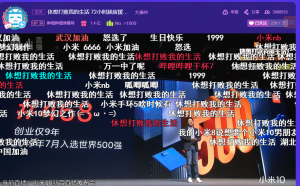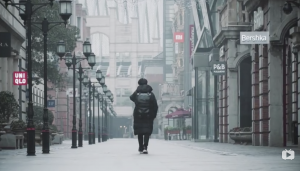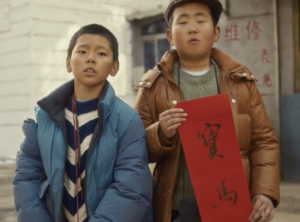
L’Oréal’s animated campaign based on the viral hit “Wolf Disco”
Spring Festival marketing in China typically includes references to many of the deeply entrenched customs associated with the holiday, while also reflecting broader changes in social habits, consumption and technology that may conflict with and change those very traditions.
This year we are seeing a dizzying array of creative and entertaining efforts by brands to resonate with consumers. The extra leisure time and family-centered hospitality that accompany the holiday will drive consumption throughout the end of this month and well into February, with the value of sales during the key “golden week” (January 24-30) forecast at around RMB 1.1 trillion ($160 billion). However, spending growth has been on the decline amid the more general slowdown in China’s economic growth — last year’s robust-sounding 8.5 percent increase in year-on-year retail sales was the first year of single-digit growth since the government began releasing data on the holiday in 2005 — which means that brands must compete more heavily to win consumers’ wallets.
Below, we share some of the key trends of this holiday season, most of which will continue to have an impact throughout the year and beyond.
1. Short video
China’s leading short-video platforms have joined the ranks of the major players in this year’s Spring Festival campaigns. Rivals Douyin and Kuaishou are racing to win over viewers with virtual “red envelope” campaigns. The Tencent-backed Kuaishou scored a major coup in securing the interactive sponsorship for this year’s CCTV Spring Festival Gala, and plans to give away more than RMB 1 billion ($140 million) during the broadcast on January 24 to viewers who interact with its app. Not to be outdone, market leader Douyin has budgeted RMB 2 billion ($280 million) in cash for its campaign. With all the attention going to short video these days, brands have taken to the format to participate in giveaways and challenges on these platforms.
2. Reaching into submerged markets
Kuaishou has a longstanding reputation for a user base that hails mainly from China’s lower-tier cities and rural areas, and that’s a consumer segment that brands can no longer afford to overlook. One of the biggest buzzwords of 2019 was “sinking market” (xiachen), a reference to how the future revenue growth of brands depends on reaching deeper into China’s hinterlands, where the lower costs of living gives consumers more disposable income.
Many 2020 Spring Festival campaigns have been designed to appeal to the xiachen demographic. In a departure from its usual focus on brands that appeal to upscale urban consumers, Tmall launched a pre-New Year shopping event (年货节) to help farmers sell 300 million kilograms of agricultural products, offering each participant a chance to earn at least RMB 1000 ($140) in extra income ahead of the holiday.
Entertainment programming around the Spring Festival is geared towards xiachen audiences, with the return of annual holiday series such as “Country Love” (乡村爱情) and “Liu Laogen” (刘老根). The major video streaming platforms are also funding the development of “mini dramas” and “micro-reality shows” to appeal to such audiences, who have shown a clear preference for the short video format over long-form video offerings that tend to cater to the aspirations of urban youth.
3. Riding the guochao wave
In 2019, brand collaborations that incorporate China’s rich cultural heritage became a major trend, and it’s one that merges seamlessly with the traditions and imagery associated with the Spring Festival.
Guochao (literally, “national trend”) refers to brands and products that incorporate a distinctly Chinese style, often tied to major cultural institutions such as the Palace Museum. These products appeal to millennial and Gen Z consumers, who have come of age with a sense of national pride and are another of the driving forces behind China’s consumption growth.
Beauty and fashion brands have been most successful in exploiting consumer tastes for guochao products, but many other types of consumer brands have gotten involved in creating culturally inspired products for the Year of the Rat. Ecommerce platform JD.com collaborated with the Palace Museum on gift boxes and promotions that include 16 domestic and international brands. Among them is confectionary brand Dove, which jointly created a gift box with the Palace Museum, staged pop-up exhibits based on the museum’s holdings, and launched a Douyin challenge to promote the products with its “every year’s good fortune” (年年得福) hashtag.
4. IP of the rat
The Year of the Rat is a big win for Disney, which has designated 2020 as the “Year of Mickey” and reportedly licensed the character for more than 20,000 SKUs in China, including a luxury collaboration with Gucci for the Chinese market and limited-edition Adidas Originals.
Brands are also creating their own rat-related IP. After flopping with last year’s “creepy” family photo campaign, Burberry scored a win this year with its new animated character, Bobo the Rat, a curious creature who enjoys traveling the world in the company of celebrities, and its Ratberry mobile game, both of which appeal to young consumers. Rag and Bone took a tongue in cheek approach with its New York City subway-inspired “pizza rat” collection, while Kenzo created an 80s retro-style “Kung Fu Rat” for Lunar New Year line, along with an interactive mobile game to promote its official flagship Tmall store.
5. Diversity in storytelling
The Spring Festival period is the peak season for the Chinese box office, with domestic productions taking over theaters, traditionally with light-hearted, feel-good themes such as Feng Xiaogang’s films or Xu Zheng’s “Lost In…” series. But as Chinese audiences have matured, so has the scope of storytelling, and this year’s slate will include ten films in varied genres with a January 25 release date.
Brands also participate in the holiday by producing short films, often incorporating themes of family togetherness in their content. This year’s crop of brand films includes increasingly diverse narratives that reflect shifting attitudes towards tradition and the anxieties that accompany such upheavals. Apple released its longest Spring Festival film yet, the eight-minute “Daughter” (女儿) a story of intergenerational love and conflict directed by Theodore Melfi. Tmall included a same-sex couple in a commercial, Airbnb created a touching animation that upended the concept of “going home,” while Nike offered a humorous twist on how “lucky money” is given and received. All of these acknowledged in some way how traditions have changed while creating emotional resonance with viewers.
6. Viral IP
China’s equivalent of the breakout TikTok hit “Old Town Road” is “Wolf Disco” (野狼Disco), by rapper Gem (aka Dong Baoshi, not to be confused with Hong Kong pop singer G.E.M., aka Tang Sze-wing). The nostalgic mash-up of Cantonese pop, northeastern dialect and Mandarin hip-hop was originally released in 2017 but blew up on Douyin after Gem performed it as an unsuccessful contestant on the third season of “Rap of China” last summer, inspiring millions of dance challenge videos.
The song was performed by various artists performed on four of the five satellite TV New Year’s Eve countdown shows on December 31, and will be featured on the biggest show of them all, the upcoming CCTV Spring Festival Gala, which will bring in two two hugely popular young pop stars, William Chan and Lay Zhang, to perform alongside Gem.
Expanding into branded content, an adaptation of “Wolf Disco” is part of L’Oréal’s Lunar New Year campaign. A short music video shows animated L’Oréal products dancing to Gem’s updated lyrics for the brand — a notable example of just how far viral IP can go and how brands can leverage it in unusual and even counterintuitive ways.





